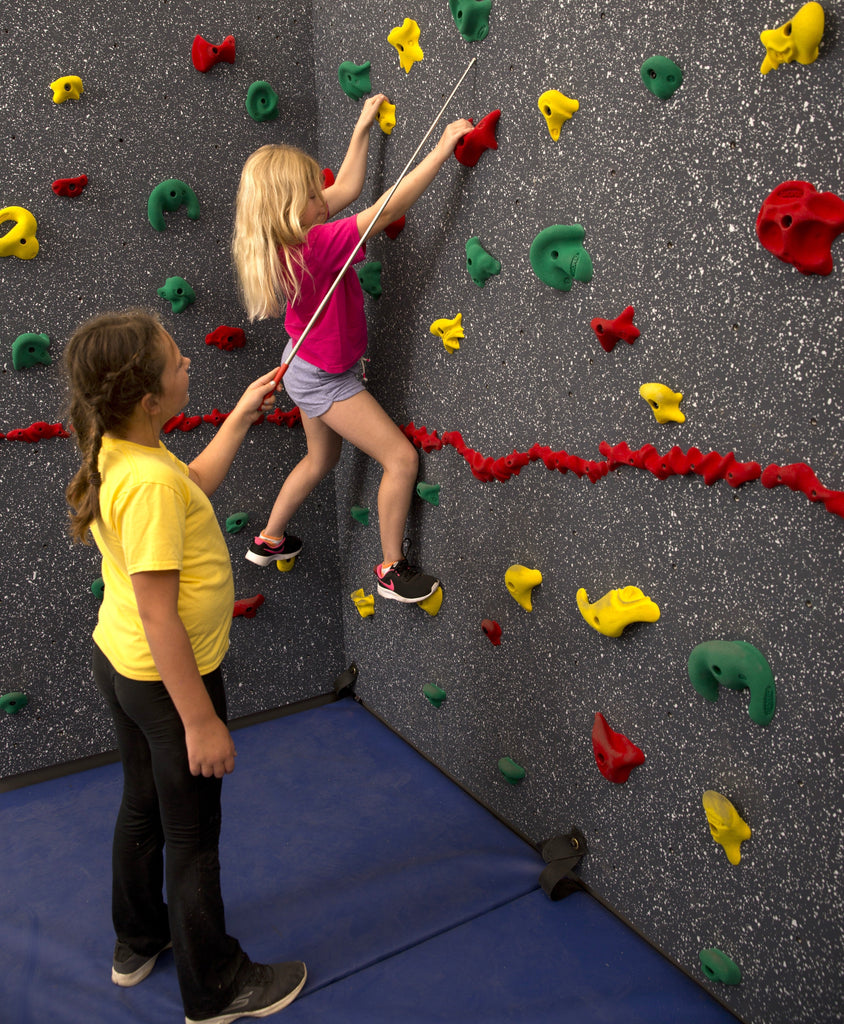
Climbing Activities for the Last Few Weeks of School
The end of the school year is a bittersweet time for students and educators alike. There’s much excitement for a vacation from daily learning, yet there’s a community that has formed and cherished bonds that are difficult to leave behind. Here are our favorite small-group activities that will help to further develop and honor those bonds.

Add On
Climbers traverse the climbing wall by repeating and adding onto each other’s moves.
Grade Level: 4 and up
Grouping: 3-5 participants
Materials Needed: Tape, optional
Advance Set Up: Use tape to mark the holds that are being used to help climbers remember the sequence (optional).
Activity:
Begin by deciding who will be the first, second, third, etc. climber. The first climber gets on the wall and does three moves. These moves must be distinct and involve no more than three hand or foot holds. Then s/he climbs down and the second climber repeats the moves of the first climber and adds one additional move, after which s/he climbs down. The third climber then gets on the wall, repeats the moves of the two previous climbers and adds one more move. The routine continues in this way, starting over with the first climber after everyone has had a turn, for as long as the group can manage. When they reach the end of the climbing wall, they can reverse direction. If at any point in time a climber cannot complete the series, simply have that climber step down and have the next climber in the rotation try. Encourage the climber who missed to try again after everyone else has had another turn. Or you can have group members let the climber know what the next hold in the sequence is.
Variations:
- To simplify the challenge, have someone point out each hold on the route as the climbers climb.
- Change the grouping to partners, each taking turns adding holds to the route.

Must Use Holds Challenge
Climbers are required to use certain holds as they traverse the climbing wall.
Grade Level: 3 and up
Grouping: 5-10 participants, depending on size of climbing wall
Materials Needed: Tape
Advance Set Up: Using tape, put a mark by the “must use” holds. Mark one hold at the start of the climb, one at the end of the climb and several in the middle of the climb.
Activity:
This activity is an introduction to climbing a route, without the challenge of having no choice in what holds to use. Climbers must climb using the required holds, but along with any other holds, to traverse the climbing wall.
Variations:
- Have climbers choose and mark the holds that are required.
- Add more required holds after each traverse to add challenge.

Climbing in the Night
Participants climb the Traverse Wall® while blindfolded in this advanced-level climbing activity.
Grade Level: 4 and up
Grouping: Partners
Materials Needed: Blindfolds, or large handkerchiefs, one per partnership
Advance Set Up: None
Activity:
Prior to beginning, review proper spotting technique with participants. Next, divide the group into two-person teams. One person is the blindfolded climber and the other is the sighted guide. The sighted guide starts the activity by carefully leading the blindfolded climber to the start of the wall. Through a series of verbal instructions (see tips) given by the sighted guide, the blindfolded climber gradually makes his/her way across the Traverse Wall®. The sighted guide is responsible for the physical safety of the climber; therefore it is imperative that accurate information is clearly communicated and that constant attention is given to the climber. At all times, the sighted partner should remain close to the climber, spotting and making sure that the climber never climbs above the three-foot height limit. When the climber reaches the end of the wall, the guide should help him/her climb down. Partners then switch roles.
Variations:
· To decrease challenge, have climbers close their eyes (no blindfolds) and give them three strikes, or three opportunities to open their eyes during the activity.
· Before the activity begins, have participants predict which role will be more challenging—climber or guide. After the activity, discuss the actual outcomes. This also makes for great journaling.
We also offer an entire team building product line which complements any rock-climbing program. They can be stand-alone events, or they can be facilitated as stations right along with the climbing wall.


Leave a comment